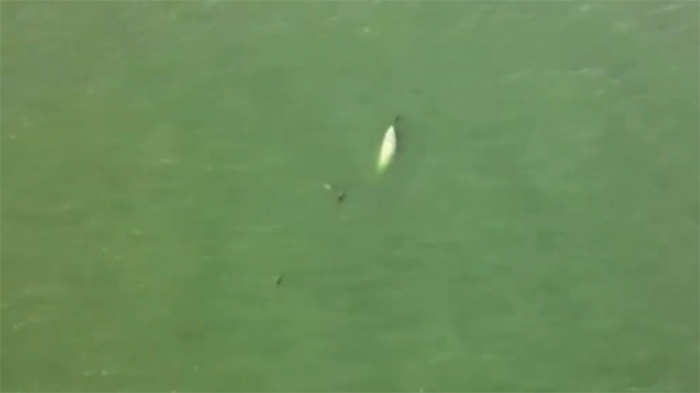The white humpback whale (Megaptera novaeangliae) was spotted on April 21, 500 meters off the coast of Fingal Head in New South Wales.
Drone footage of the white humpback whale. (Video: Brayden Blake)
The first person to spot the white whale was 16-year-old Brayden Blake. While surfing, Blake fell off his board and heard the whale’s calls underwater. After returning to the beach, he quickly spotted the white whale and rushed home to get his camera-equipped drone. He then filmed the whale swimming alongside a pod of dolphins.
“I often see humpback whales, but this one was unlike any I had seen before,” Blake shared. “Every time it surfaced to breathe, it revealed its white body instead of the black or dark gray typical of other humpbacks. The white whale disappeared after about 20 minutes,” he noted.
The individual Blake observed closely resembles the famous albino humpback whale Migaloo, which first appeared in Queensland, Australia, in 1981. However, this new whale is smaller than Migaloo and has several gray patches, while Migaloo is completely white. Therefore, some experts suspect this is likely the second white humpback whale from the same population.

Every time it surfaces to breathe, it reveals its white body instead of the black or gray.
“This is the first time I can say I’m looking at another white whale besides Migaloo,” said Wally Franklin, a marine ecologist at Southern Cross University, Australia. “This is extremely rare.”
The sighting of a second white whale has raised speculation that it could be Migaloo’s offspring or a close relative. This population of humpback whales migrates through Australian waters from May to November before heading south to Antarctica to feed on krill. Migaloo is typically spotted from late June to November almost every year. However, researchers suspect that this younger male whale is just beginning its migration journey, which is why it appeared offshore in April.
“The timing of the sighting is very fitting for a young whale, as this is the beginning of the migration season,” Franklin stated. The age of the new whale could support the theory that it is Migaloo’s son, as white skin color often has a genetic basis. It is likely to appear again and may be photographed clearly before the migration season ends, helping to reveal the relationship between the two individuals based on fin and tail shape.
However, not all experts believe that the white humpback whale swimming near Fingal Head is related to Migaloo. The main reason is its patchy white skin. According to Vanessa Pirotta, a wildlife scientist at Macquarie University, Australia, and a specialist in marine mammals, it is not an albino whale, and the two animals are unrelated.
The white coloration in whales can be caused by two distinct syndromes: albinism and leucism. Migaloo has albinism, which means that genetically, it cannot produce melanin, the pigment responsible for skin, fur, and eye color. Albinism can also cause animals to have red eyes and affect their vision. However, the new white humpback whale has many gray patches, indicating it has leucism, a syndrome that affects the ability of individual pigment cells to produce melanin rather than preventing all pigment-producing cells from functioning.
Both albinism and leucism are extremely rare in whales, with a ratio of 1 in 10,000 in humpback whales, according to Erich Hoyt, a researcher at the Whale and Dolphin Conservation (WDC) in the UK. In other animal groups, these syndromes can significantly reduce the survival chances of affected individuals. The only way to determine whether the two animals are related is to obtain genetic samples such as tissue or feces from the new white whale. In 2004, researchers collected genetic samples from Migaloo, according to the Pacific Whale Foundation, a nonprofit organization in Hawaii. If similar samples can be collected from the new white humpback whale, researchers will be able to draw accurate conclusions.


















































